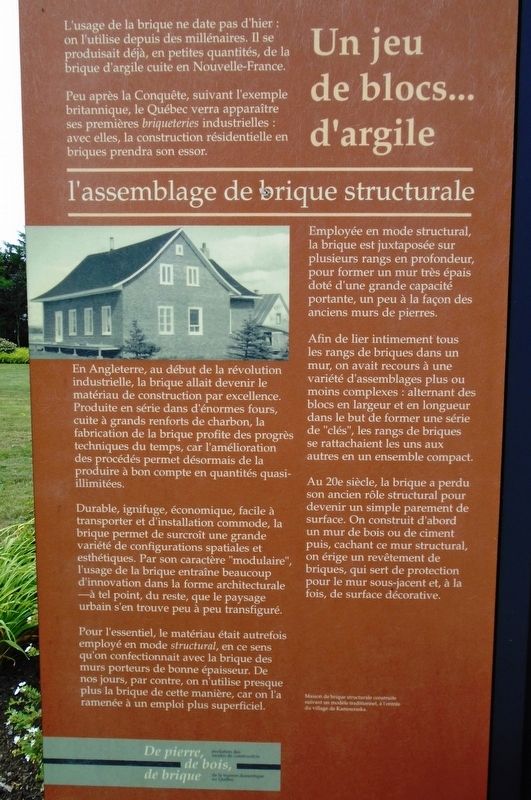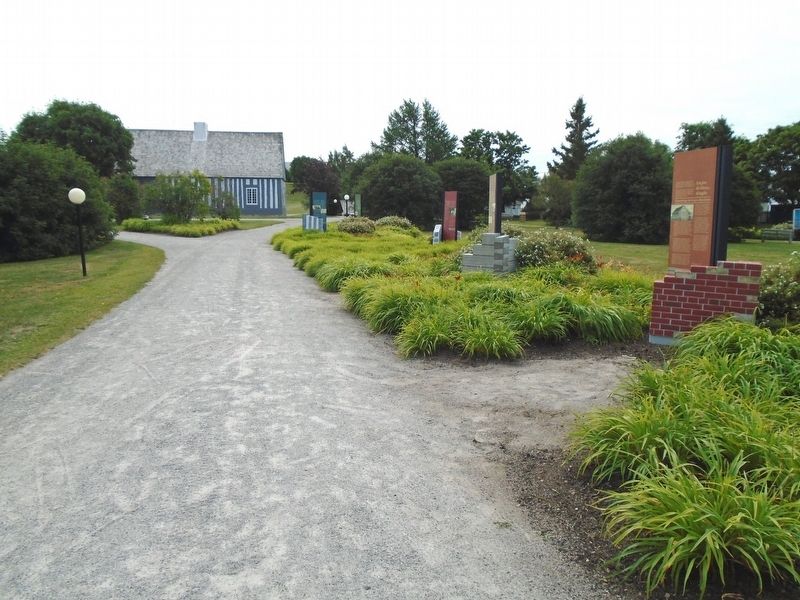Un jeu de blocs... d'argile / A set of blocks ... of clay
l'assemblage de brique structurale / Structural brick assembly
— De pierre, de bois, de brique / Stone, Wood, Brick —
L'usage de la brique ne date pas d'hier : on l'utilise depuis des millénaires. Il se produisait déjà, en petites quantités, de la brique d'argile cuite en Nouvelle-France.
Per après la Conquête, suivant l'exemple britannique, le Québec verra apparaître ses premières briqueteries industrielles : avec elles, la construction résidentielle en briques prendra son essor.
En Angleterre, au début de la révolution industrielle, la brique allait devenir le matériau de construction par excellence. Produite en série dans d'énormes fours, cuite à grands renforts de charbon, la fabrication de la brique profite des progrès techniques du temps, car l'amélioration des procédés permet désormais de la produire à bon compte en quantités quasi-illimitées.
Durable, ignifuge, économique, facile à transporter et d'installation commode, la brique permet de surcroît une grande variété de configurations spatiales et esthétiques. Par son caractère "modulaire", l'usage de la brique entraîne beaucoup d'innovation dans la forme architecturale-à tel point, du reste, que le paysage urbain s'en trouve peu à peu transfiguré.
Pour l'essentiel,
le matériau était autrefois employé en mode structural, en ce sens qu'on confectionnait avec la brique des murs porteurs de bonne épaisseur. De nos jours, par contre, on n'utilise presque plus la brique de cette manière, car on l'a ramenée à un emploi plus superficiel.Employée en mode structural, la brique est juxtaposée sur plusieurs rangs en profondeur, pour former un mur très épais doté d'une grande capacité portante, un peu à la façon des anciens murs de pierres.
Afin de lier intimement tous les rangs de briques dans un mur, on avait recours à une variété d'assemblages plus ou moins complexes : alternant des blocs en largeur et en longueur dans le but de former une série de "clés", les rangs de briques se rattachaient les uns aux autres en un ensemble compact.
Au 20e siècle, la brique a perdu son ancien rôle structural pour devenir un simple parement de surface. On construit d'abord un mur de bois ou de ciment puis, cachant ce mur structural, on érige un revêtement de briques, qui sert de protection pour le mur sous-jacent et, à la fois, de surface décorative.
[La légende de la photo se lit]
Maison de brique structurale construite suivant un modèle traditionnel, à l'entrée du village de Kamouraska.
The use of brick is not new: it has been used for millennia. Small quantities of
After the Conquest, and following the British example, Quebec saw its first industrial brickworks built: with them, brick residential construction took off.
In England, at the beginning of the Industrial Revolution, the brick became the building material of choice. Produced in huge kilns baked with heavy coal, brick manufacturing took advantage of the technical progress of the time because process improvements produced bricks cheaply and in almost unlimited quantity.
Durable, flame retardant, economical, easy to transport and easy to install, the brick also allowed a wide variety of spatial and aesthetic configurations. By its "modular" character, the use of brick brought much innovation in architectural form-to such an extent, moreover, that the urban landscape was gradually transfigured.
For the most part, the material was formerly used in the structural mode, in the sense that thick load-bearing walls were made with brick. Nowadays, however, brick is hardly used in this way and has been reduced to a more superficial role.
Used in structural mode, brick is juxtaposed in several rows in depth to form a very thick wall with a large load bearing capacity, a bit like old stone walls.
In order to intimately bind all the rows of bricks in a wall, a variety of more or less complex assemblies are used:
In the 20th century, brick lost its former structural role to become a simple surface siding. First, a wall of wood or cement is built and, hiding this structural wall, a brick covering is erected, which serves as protection for the underlying wall and at the same time as a decorative surface.
[Photo caption reads]
Structural brick house built according to a traditional model, at the entrance to the village of Kamouraska.
Topics. This historical marker is listed in these topic lists: Architecture • Industry & Commerce • Settlements & Settlers.
Location. 48° 29.072′ N, 68° 29.731′ W. Marker is in Rimouski, Québec, in Rimouski-Neigette. Marker is on boulevard du Rivage (Québec Route 132), on the right when traveling north. Marker is on the grounds of Maison Lamontagne House Historic Site. Touch for map. Marker is at or near this postal address: 707 boulevard du Rivage, Rimouski QC G5L 7L3, Canada. Touch for directions.
Other nearby markers. At least 8 other markers are within walking distance of this marker. Une forêt pour sa maison / A forest for his house (here, next to this marker); Du moulin à la maison / From the mill to the house (a few steps from this marker); Pierre des champs... pierre des villes / Stones of the fields... stones of the cities (a few steps from this marker); Sur un squelette... de bois / On a skeleton... of wood (a few steps from this marker); Façons de France ...en Amérique / French Ways ...in America (a few steps from this marker); Le temps de s'établir / Time to Settle (within shouting distance of this marker); La maison urbaine en Nouvelle-France / The Urban House in New France (within shouting distance of this marker); La maison Londonienne / The London house (within shouting distance of this marker). Touch for a list and map of all markers in Rimouski.
Regarding Un jeu de blocs... d'argile / A set of blocks ... of clay. Marker is one of a series highlighting the evolution of Quebec domestic architecture, titled, Stone, Wood, Brick.
Also see . . .
1. Maison Lamontagne House Historic Site. (Submitted on November 27, 2018, by William Fischer, Jr. of Scranton, Pennsylvania.)
2. Traditional French-Canadian ( Quebec ) Architecture. (Submitted on December 5, 2018, by William Fischer, Jr. of Scranton, Pennsylvania.)
Credits. This page was last revised on January 20, 2020. It was originally submitted on November 27, 2018, by William Fischer, Jr. of Scranton, Pennsylvania. This page has been viewed 124 times since then and 9 times this year. Photos: 1, 2. submitted on November 27, 2018, by William Fischer, Jr. of Scranton, Pennsylvania.

